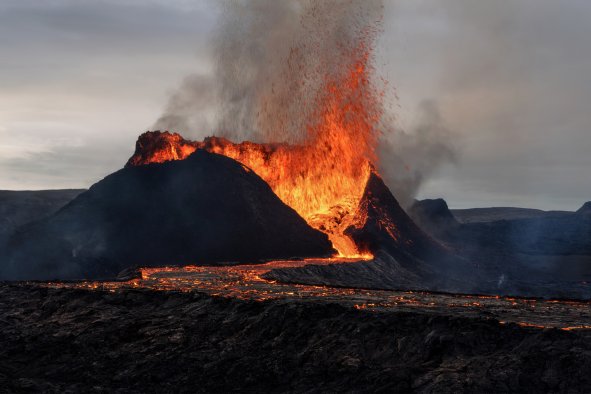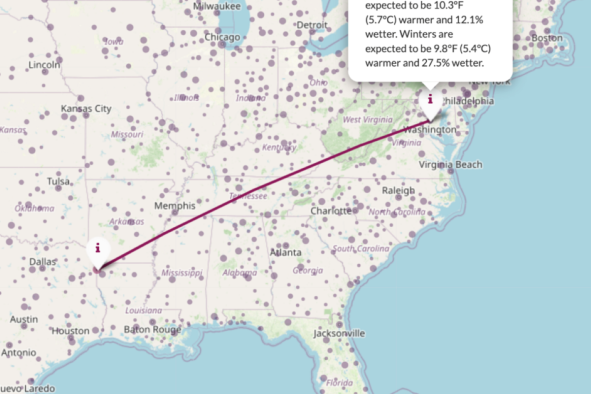The sweltering temperatures scorching most of the Midwest, Northeast, East Coast and South this week can be seen on a new NASA map.
The map was created using satellite observations on Wednesday, with temperatures about 6 feet above the ground predicted by NASA's Goddard Earth Observing System model. The darkest red color on the map indicates that temperatures were 93 degrees F or higher.
The intense temperatures, which have lasted much of this week, have been caused by a phenomenon known as a heat dome. These domes are characterized by a large area of high-pressure air that traps warm air underneath it, leading to prolonged periods of excessive heat. June's heat dome has meant that "people in the Midwest and Northeast saw a string of days with sweltering temperatures that tied or broke calendar-day records in several states," the NASA Earth Observatory's website said.
"The hottest temperatures of the year so far will impact much of the Midwest to Northeast," the National Weather Service (NWS) predicted Monday on X (formerly Twitter).
"Widespread daily records are likely for daytime heat, with some monthly records possible," the NWS continued. "Heat index readings are expected to peak from 100 to 105 degrees in many locations. By this weekend, the most intense heat will shift south from New England towards the Northeast urban corridor and Mid-Atlantic."
Several locations across the country saw record-high temperatures, with Boston hitting 98 degrees—breaking its 100-year heat record—and Hartford, Connecticut, seeing 97 degrees on Wednesday.
A heat dome forms when a strong high-pressure system develops in the upper atmosphere, acting like a lid and trapping warm air near the ground. The air underneath the dome then sinks, heating up even more and leading to extreme temperatures during the day and night. Heat domes can last for several days or even weeks.
Extreme heat waves can be deadly, with heat-related conditions killing twice as many people a year on average as hurricanes and tornadoes combined. Heat waves like these can be particularly dangerous for the elderly.
"Extreme heat worsens common age-related health conditions such as heart, lung and kidney disease and can cause delirium," Deborah Carr, a Boston University sociologist who specializes in the study of aging, told the NASA Earth Observatory's website.
With the increasing effects of climate change, heat waves like this one are becoming more and more common: NASA's Goddard Space Flight Center researchers found that between 1980 and 2023, summer heat waves across the U.S. doubled in frequency.
"We have warmed up the planet by about 2 degrees Fahrenheit in the last century or so," Gavin Schmidt, the director of NASA's Goddard Institute for Space Studies, told the NASA Earth Observatory. "That is juicing the extremes, so the number of times places are exceeding 90 or 100 degrees Fahrenheit is going up—and not just by a little bit. It's gone up four, five, seven times more than before."
Carr's research recently found that the Northeast and Midwest regions may be exposed to the steepest increases in heat, compared with historical temperatures of any location. This can be very dangerous to the large number of older people who live in these states.
"Older adults who are accustomed to the New England chill may not fully understand the threats an extreme heat wave can pose, and they may underestimate the harm they might suffer from a day in the hot sun," she said.
The NWS recommends using air conditioning if possible or finding locations that have air conditioning if none is available at home.
"Use air conditioning to stay cool at home or go to a place that has air conditioning. If you don't have home air conditioning, continue to seek out cool spaces each day as long as it remains hot, and for a few days after if your home is still hot. Check on vulnerable friends, family members and neighbors," the NWS said in a heat advisory for New York state last weekend.
"Anyone overcome by heat should be moved to a cool and shaded location. Heat stroke is an emergency! In cases of heat stroke call 911," the NWS added.
For now, the nation's heat wave isn't over yet, with high temperatures expected into the weekend.
On Wednesday, the NWS said in a forecast discussion: "Locations from the Midwest into Mid-Atlantic should continue to see temperatures 10-15F above normal through the weekend. These anomalies would translate to highs well into the 90s, along with lows in the upper 60s to upper 70s providing little overnight heat relief. Daily records for max/warm min temperatures will be possible within the above areas through the weekend, up through warm minimum temperatures early Monday."
The heat wave is expected to move toward the Southeast in the subsequent days.
"The ongoing heatwave will likely spread to the Mid/Deep South and Southeast early next week. Heat index values may exceed 110 degrees in some places," the NWS posted to X on Friday.
Do you have a tip on a science story that Newsweek should be covering? Do you have a question about heat waves? Let us know via science@newsweek.com.
Disclaimer: The copyright of this article belongs to the original author. Reposting this article is solely for the purpose of information dissemination and does not constitute any investment advice. If there is any infringement, please contact us immediately. We will make corrections or deletions as necessary. Thank you.



